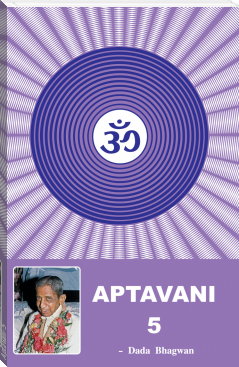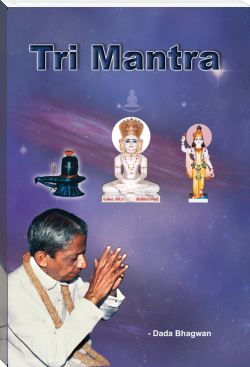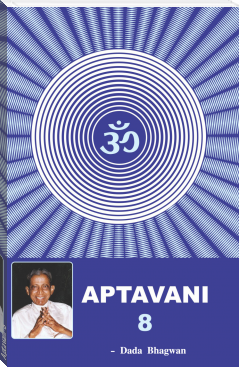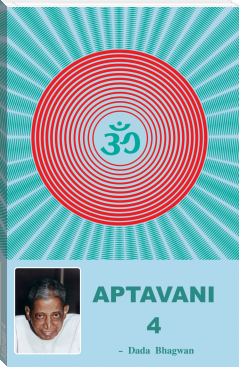Aptavani-5 by Dada Bhagwan (self help books to read .TXT) 📖

- Author: Dada Bhagwan
Book online «Aptavani-5 by Dada Bhagwan (self help books to read .TXT) 📖». Author Dada Bhagwan
When there is involvement in circumstances, there will be uneasiness and when one dwells in the Self, there is continuous steadiness! The Self ‘knows’ the state of the non-Self complex and the Self stays the Self. Thus, all the barriers are broken down and everything is cleansed.
The Gnani is always in a state that is detached from the body. He is only in the Knower-Seer state. Therefore, no pain can touch Him at all. The nature of the Self is such that no pain can touch It!
The one who lays awake all night long after getting hurt and does ‘invention’ (analyses of his situation and looks for solutions) will make spiritual progress. The progress of the one remaining in comfort (no worldly problems) will be clouded.
To attain moksha is the right of every human being. One only has to surrender to the Gnani.
In the current time cycle Akram Vignan is the last train to moksha; whoever grabs this opportunity will quickly attain moksha. After this there is no hope for thousands of years!
Changes in lifespan cannot be made by anyone, whether one is a saint, a highly evolved Soul, a Gnani, or a Tirthankar.
In samadhi maran (death while being in the state as the Self) physical pain will not torment him at all. His final hour will be one of absolute samadhi (state of being unaffected despite all external and internal turmoil and being the Self). All those who have received Self-realization through Akram Vignan will see Dadashri in their final hour or they will only have the awareness of ‘I am pure Soul’. The body complex will be experienced as a separate entity; the one dying will be experienced as a separate entity. A balance sheet of the entire life will present at the time of death.
The Siddha Bhagwants (absolutely enlightened Ones without a body) are located only in the Siddha Kshetra (location at the crest of the universe where all absolutely liberated Souls ultimately reside). They are in absolute knowledge (kevalgnan). They are in eternal infinite bliss ( param sukh) and they are able to ‘see’ and ‘know’ the entire universe.
‘To see the pure Soul’, what does it mean? The Soul cannot be seen with these physical eyes. If a valuable diamond is placed in a box and the box is closed, it will be in the awareness that, ‘there is a diamond in this box and it is of such and such kind’; similarly, after attaining Self-realization, the mind-intellect-chit-ego will all accept that, ‘I verily am pure Soul and everyone else is pure Soul’; then there will be no doubt!
Worshipping the Gnani is same as worshipping the pure Soul, and it is the same as worshipping the absolute Self (Parmatma), and that worship is the cause for moksha.
What is the experience of the bliss of the Self like? How can one know it? The hallmark of the bliss of the Self is that there is constant nirakudata (freedom from internal and externally induced agitation and perplexity). If any perplexity or uneasiness is experienced, then know that the awareness as the Self (upayog) has been missed. Whether the experience is that of suffering of pain (ashata-vedaniya) or experience of pleasure (shata-vedaniya), the ‘knowing’ of these is the experience as the Self.
Who has bodily pain? It happens to the body, not to the Self. That too is vyavasthit (scientific circumstantial evidences). When there is experience of suffering (vedana), You have to comfort ‘Chandubhai’ and talk to him, ‘Do you have a bad headache? It will get better soon!’ And if you say, ‘I am in pain’, then it clings to you. Change the dictionary. Pain is pleasant and pleasure is unpleasant. Just ‘know’ that, ‘All these experiences of pain and pleasure are happening to the neighbor.’
As the pure Self, One should start the interaction of being separate with the relative self (prakruti). Remain separate from the relative self and talk to the relative self, like a warrior; then the tormenting of the relative self will go away. Stand ‘Chandubhai’ in front of a mirror, pat him on the back and talk to him, comfort him.
The Lord has said that Knowledge, vision, conduct and penance (Gnan, darshan, charitra and tapa) are the four foundation pillars of moksha. The highest outer penance is that of unodari (eating less food than what one has the appetite for). And for final liberation, inner penance is required. Inner penance means that, at the time of terrible pain You remain in the home department and do not move away from being the Self. No shifting in the relative self happens whatsoever; that is the penance to be done! Being firm in, ‘All these are results of the non-Self, they are not Mine’, is the penance. And that is what gives moksha! Knowing that the suffering is of the non-Self leads to the continuous ‘knowing’ of this. And if it is felt that, ‘this is happening to me’, then one has to suffer. Furthermore if it is expressed that, ‘I can’t tolerate this’, the suffering is multiplied tenfold! The effect (asar) happens according to the words spoken. There (where suffering is concerned) you get the work done with chivalry.
Just look at what the nature of the Self is like! It immediately becomes what it envisions. If it envisions one with happiness, it becomes happy, and if it envisions being sad, it becomes sad! Therefore, be aware that envisioning of sadness does not arise. You should not say, ‘my head is hurting’; there you can only say, ‘Chandubhai’s’ head is hurting!’ Do not become engrossed with the results that happen to the non-Self.
The Gnani as well as the Tirthankars are subject to the suffering of pain (ashata-vedaniya), but they simply ‘know’ the suffering; they ‘know’ it through absolute knowledge.
The chit is only to be kept in the Self, not in the suffering or in temporary things. When the chit remains in the eternal it becomes pure. Thereafter one becomes a videhi (beyond the body complex). The energy of the Self is only in the realm of the Self. Once that arises the work is done.
What is known as obstinacy (aadayee)? Say a person makes a mistake and he is aware of it but if someone asks him why he made the mistake, he will respond by insisting that it was the right thing to do; that is known as obstinacy. If he is aware of the mistake and covers it up; that is considered the biggest form of obstinacy.
There are two types of prizes. One is to win a lottery and the other is to be robbed; both are scientific circumstantial evidences.
The one whose speech is never associated with sect based divisiveness and entrenched opinions, where the speech is absolutely about the Self, is known as the absolute Self (Brahmaswaroop).
There are infinite Souls. In the final liberation state each and every Soul is separate and remains in eternal bliss of the Self.
The entire worldly life and its interactions are in the form of discharge (galan) and it is scientific circumstantial evidences (vyavasthit). All five senses are subject to unfolding karma effect (udayadhin).
What causes bondage of karma? The very belief, ‘I am Chandubhai’, is the root cause of bondage of karma. One only has to understand the facts. This is a science.
When thoughts happen and they torment you, You are only to ‘see’ them as separate. Thoughts arise in the mind. The mind will say, ‘What if the car collides?’ There You are to simply ‘see’ the thought and sit in the car peacefully and not get engrossed in the mind. When excessive pain happens tell it, ‘Go to Dada.’
The intellect (buddhi) does not let you get out of the worldly life. The intellect shows where profit lies and where loss lies; it causes inner burning. The inner burning stops forever when one is graced by the Gnani! Where there is right intellect (samyak buddhi) there are no sect based opinions! There is no divisiveness of, ‘This is mine and this is yours’!
The ‘outer’ intellect is ‘mechanical’ and the ‘inner’ intellect is what makes one independent. That intellect too is ‘mechanical’. The independence it gives you leaves no superior over you. The ‘mechanical’ intellect gives worldly things.
‘Who am I? What is the basis of my existence?’ It is imperative to know adhaar and adhaari,meaning what support is and what being supported is. ‘What is worth doing in the world, what is not worth doing’, ‘what is to be known and what is not to be known’; only this much needs to be understood.
Viraha (pining, the fire of separation from a loved one) means there is no state of ease; it is only then that one becomes free from the worldly life. The pining of separation should be for the Gnani. This separation generates ‘electricity’ within and it energizes the Self! Viraha is considered a very valuable thing. Those who have come to know the Gnani, for many an era, come to have viraha. Such individuals are bound for moksha.
Our real nature is Sat Chit Anand (sat – eternal, chit – knowledge and vision, anand – bliss). The Gnani Purush fractures your wrong belief and establishes the right one. After that You attain the awakened awareness, ‘I am pure Soul’; You attain Gnan and then there is constant awareness! After that illusion (maya) and illusory attachment (moha) go away.
The illusory attachment (moha) Gautam Swami had for Lord Mahavir Swami is called prashasta moha (praiseworthy and the best kind of illusory attachment). With that all worldly illusory attachments get destroyed and moksha is surely attained. Praiseworthy moha means attachment that happens for the one who will take You to moksha. It is not harmful moha. It will result in moksha; there may be a slight delay, but so what? Attachment for the Vitarags, attachment for the things that impart non-attachment (vitaragata) is called prashasta moha.
Where there is doubt (shanka), there is the invasion of a cyclone! And for final liberation one has to be entirely doubt-free (nihshank)! Be doubt-free about the Self. That freedom from doubt can only happen when the Gnani Purush gives the knowledge of the Self! Then there will be no charging of new karma!
If you want to progress in the world, you follow the path of intellect (buddhi) and if you want to attain moksha, follow the path of not using intellect (abuddha)! The wrong intellect (viparit buddhi) turns into the right intellect (samyak buddhi) through satsang with the Gnani and it takes you to final liberation! When one becomes entirely free from intellect, absolute knowledge will be attained. There is no use for intellect to attain final liberation.
Swachhand (to act according to one’s own intellect in matters of salvation and spiritual progress) can’t be stopped without the Agna (instructions of the Gnani Purush), and unless swachhand is removed there will be no moksha. Therefore, the Agna of the Gnani is religion (dharma) and it is also penance (tapa)! The worship with understanding of the Agna is the only way to moksha. Practicing yoga gives concentration; there is steadiness of the mind for a little while. And if it becomes above normal, it will cause great afflictions. It will





Comments (0)